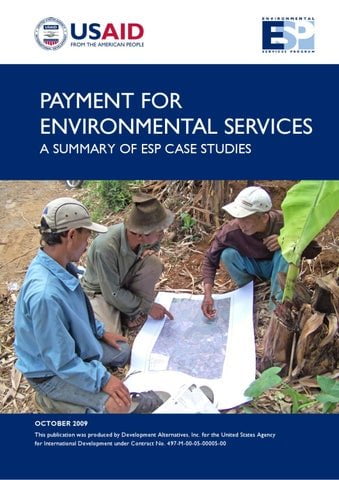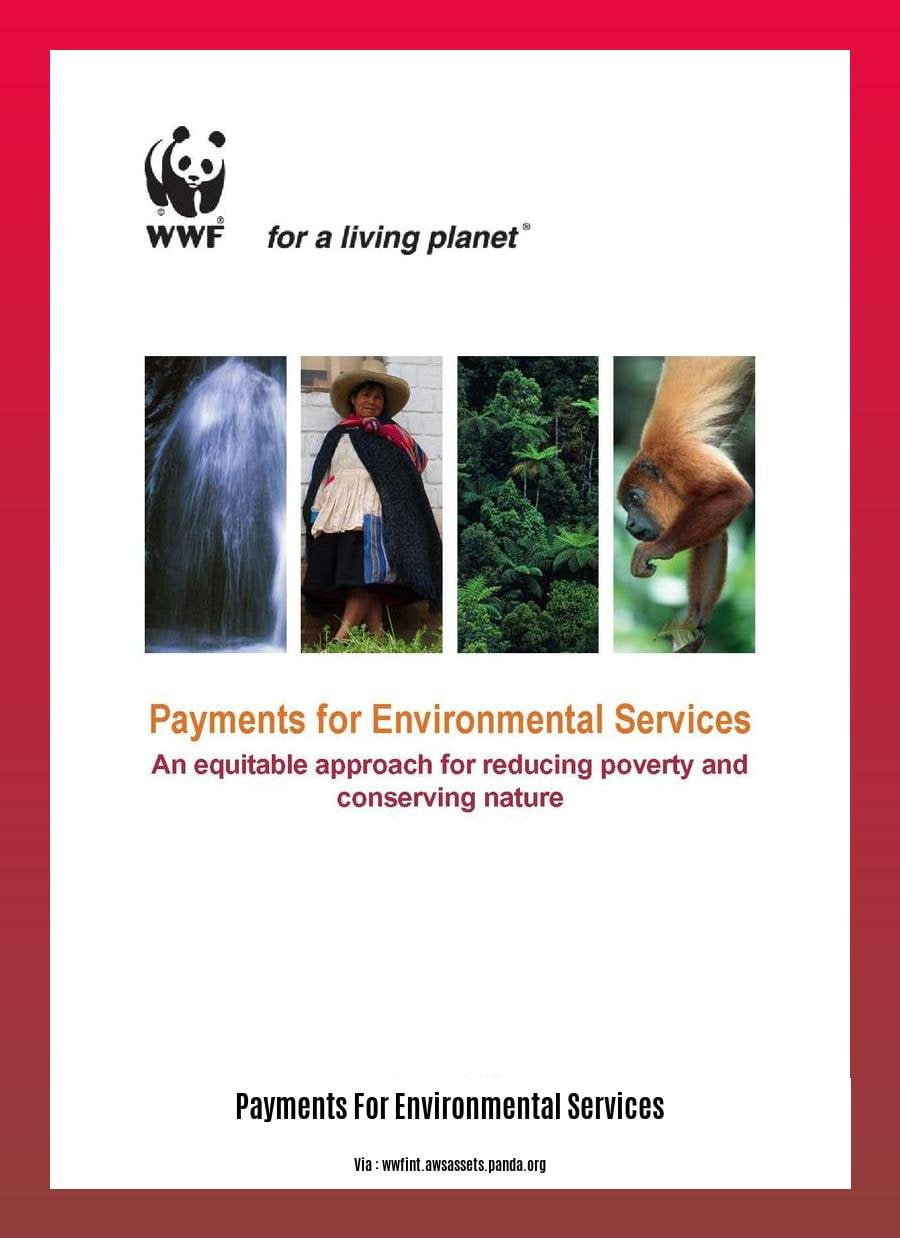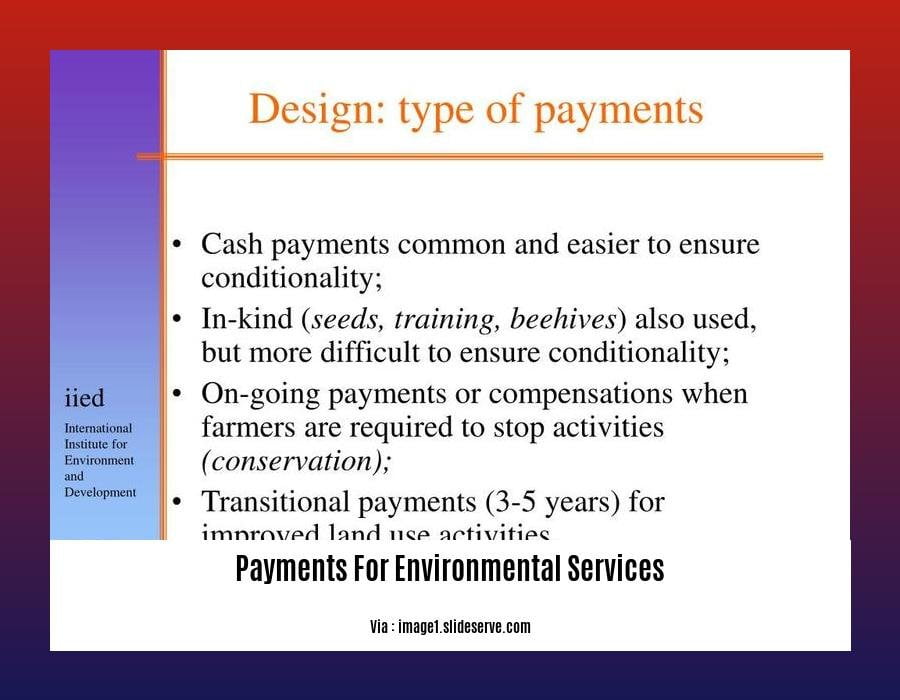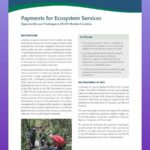Harnessing Payments for Environmental Services: A Tool for Sustainable Development: Payments for Environmental Services (PES) schemes offer a promising approach to environmental conservation and rural development. By incentivizing landowners and communities to manage their natural resources sustainably, PES programs can mitigate climate change, conserve biodiversity, and protect watershed health. However, carefully designed and implemented PES schemes are key to ensuring equitable benefit-sharing, fostering local ownership, and achieving lasting environmental outcomes.
Key Takeaways:
- PES provides financial rewards to landowners or managers for protecting or restoring natural resources that provide environmental benefits.
- PES is a market-based approach that aims to create a demand for environmental services.
- Successful PES programs require clear rules for land management and equitable benefit-sharing.
- PES can contribute to sustainable development by incentivizing sustainable land use practices, mitigating climate change, and conserving biodiversity.
Payments for Environmental Services

What are Payments for Environmental Services (PES)?
PES is a mechanism that provides financial incentives to landowners or farmers for managing their land in ways that benefit the environment. These services could include protecting water quality, conserving biodiversity, or sequestering carbon.
How does PES work?
PES programs are typically voluntary agreements between service users (beneficiaries) and service providers (landowners). The beneficiaries pay for the ecosystem services provided by the landowners, who agree to implement specific land management practices to maintain or enhance those services.
Benefits of PES
- Environmental conservation: PES can incentivize land management practices that protect and restore ecosystems.
- Rural development: PES programs can provide additional income to farmers and landowners, improving their livelihoods.
- Market-based conservation: PES creates a market for ecosystem services, allowing them to be valued and traded.
Challenges of PES
- Measuring and monitoring: Quantifying the environmental benefits of land management practices can be challenging.
- Enforcement: Ensuring that landowners adhere to agreed-upon practices is crucial for the success of PES programs.
- Equity: Distributing benefits equitably among stakeholders is essential to avoid unintended consequences.
Examples of PES
- Costa Rica: PES programs have helped protect forests and conserve biodiversity.
- Indonesia: PES schemes have reduced deforestation by providing incentives for sustainable agriculture.
- United States: Farmers are paid for practices that reduce soil erosion and water pollution.
Conclusion
PES is a promising tool for promoting sustainable land management, conserving biodiversity, and improving rural livelihoods. By providing financial incentives for environmental stewardship, PES programs can help balance economic interests with environmental protection.
Delve into the history of payment for environmental services, uncovering its evolution and significance in ecological stewardship. Explore the fascinating history of payment for ecosystem services, tracing its roots and understanding its role in sustainable development. Discover what environmental services are and learn about their vital contributions to human well-being. Gain insights into environmental services hourly pay and explore career opportunities in this burgeoning field. Unravel the complexities of what payment environment is and its impact on environmental conservation efforts.
Benefits of PES Schemes
The Benefits of PES Schemes are multifaceted, encompassing both environmental conservation and rural development. These schemes:
- Safeguard the Environment: PES incentivizes landowners to adopt sustainable land management practices, protecting ecosystems, wildlife habitats, and watersheds.
- Mitigate Climate Change: Trees planted through PES schemes absorb carbon, reducing greenhouse gas emissions.
- Promote Biodiversity: PES supports the conservation of natural habitats, ensuring the survival of endangered species and maintaining genetic diversity.
- Boost Rural Economies: PES provides additional income to farmers and landowners, improving livelihoods and fostering community development.
- Foster Innovation: PES encourages the development of new technologies and approaches for sustainable land management, such as precision agriculture.
Key Takeaways:
- PES schemes promote environmental conservation by incentivizing sustainable land management practices.
- These schemes contribute to mitigating climate change and conserving biodiversity.
- PES supports rural economies by providing additional income to farmers and landowners.
- PES fosters innovation in sustainable land management practices.
Citations:
- Wikipedia: Payment for Ecosystem Services
- Ecosystem Marketplace: News and Features on Payments for Ecosystem Services
Challenges of PES Schemes

The concept of Payments for Environmental Services (PES) is a promising tool for encouraging sustainable land management practices, mitigating climate change, and conserving biodiversity. While PES schemes have achieved significant success in various contexts, they also face some inherent Challenges of PES Schemes.
Unclear Service Definitions: Many schemes fail to adequately define the specific ecosystem services being supported. This lack of clarity can lead to confusion among participants about what services they are expected to pay for or provide.
Ambiguous Receiver Responsibilities: The responsibilities of receivers in PES schemes are often poorly defined. This ambiguity can result in uncertainty about the actions required to qualify for payments and the level of effort expected from landowners and farmers.
Conflation of Services and Actions: PES schemes often conflate ecosystem services with the actions taken to support them. This conflation can make it difficult to distinguish between the value of the service itself and the costs associated with its provision.
Equitable Benefit Distribution: Ensuring that the benefits of PES schemes are equitably distributed among participants can be a challenge. Payments may disproportionately favor certain groups, such as those with larger landholdings or those who can easily adopt required practices.
Measurement and Monitoring Difficulties: Accurately measuring and monitoring the environmental benefits of PES schemes can be complex and costly. Without reliable data, it is difficult to verify the effectiveness of the scheme and justify continued payments.
Key Takeaways:
- Clearly define the supported ecosystem services to avoid confusion and ensure targeted interventions.
- Establish clear responsibilities for receivers to promote understanding and accountability.
- Distinguish between ecosystem services and actions to avoid conflating costs and benefits.
- Prioritize equitable benefit distribution to maximize PES’s social and environmental impact.
- Invest in robust monitoring systems to track environmental outcomes and justify payments.
Citations:
Payment for Environmental Services: A critical review of schemes
Payments for Environmental Services: A Survey and Assessment of Current Schemes
Future Directions for PES Schemes
PES schemes have emerged as a powerful tool for promoting environmental conservation and sustainable land management. However, as we look ahead, it’s essential to consider emerging trends and future directions to enhance their effectiveness and impact.
Innovations in Monitoring and Measurement
Accurate monitoring and measurement systems are crucial for evaluating the environmental and social impacts of PES schemes. Advanced technologies, such as remote sensing and aerial imagery, can provide valuable data on land use changes, biodiversity, and carbon sequestration. This data can help refine PES contracts, ensuring that they are delivering the desired outcomes.
Expanding Beneficiaries and Services
Traditionally, PES schemes have focused on compensating landowners for environmental services like forest conservation or carbon sequestration. However, future schemes should consider expanding the range of beneficiaries and services to include indigenous communities, smallholder farmers, and those providing ecosystem services in urban areas.
Integration with Other Conservation Strategies
PES schemes can be effectively combined with other conservation approaches, such as protected area management or community-based natural resource management. By leveraging synergies between different strategies, we can enhance the overall effectiveness of environmental conservation efforts.
Addressing Climate Change and Biodiversity Loss
PES schemes offer a promising mechanism for addressing urgent global challenges like climate change and biodiversity loss. By incentivizing practices that reduce greenhouse gas emissions or protect threatened species, PES can contribute to a more sustainable and resilient future.
Key Takeaways:
- Innovations in monitoring and measurement will ensure the accuracy and effectiveness of PES schemes.
- Expanding beneficiaries and ecosystem services will broaden the impact and reach of these programs.
- Integration with other conservation strategies will enhance overall effectiveness.
- PES schemes can play a vital role in addressing climate change and biodiversity loss.
[Citation]
- Payments for Environmental Services: A critical review of schemes, concepts, and practice in Brazil
- GUIDELINES FOR PLANNING AND DESIGNING PAYMENT FOR ENVIRONMENTAL SERVICES SCHEMES
FAQ
Q1: What are Payments for Ecosystem Services (PES)?
A1: Payments for Ecosystem Services (PES) are incentive programs that compensate landowners or managers for implementing practices that provide ecological benefits. These practices can include conserving forests, planting native species, or reducing fertilizer use, which in turn provide ecosystem services such as clean water, carbon sequestration, and biodiversity protection.
Q2: How do PES schemes work?
A2: PES schemes typically involve three parties: the service provider (landowner or manager), the service user (beneficiary of the ecosystem services), and a facilitator or intermediary. The service user pays the service provider for implementing practices that generate the desired ecosystem services, based on agreed-upon performance metrics and monitoring systems.
Q3: What are the benefits of PES schemes?
A3: PES schemes offer numerous benefits, including:
- Environmental conservation: Protecting natural ecosystems and promoting sustainable land management practices, resulting in improved water quality, carbon sequestration, and biodiversity conservation.
- Economic incentives: Providing financial incentives for landowners and managers to adopt sustainable practices, fostering rural development and job creation.
- Equity and social justice: Addressing social inequalities by ensuring that marginalized communities benefit from ecosystem services and have a stake in their conservation.
Q4: What are the challenges associated with PES schemes?
A4: PES schemes face several challenges, such as:
- Measurement and verification: Accurately measuring and verifying the environmental benefits generated by PES practices can be complex and costly.
- Additionality: Ensuring that the ecosystem services generated by PES would not have occurred without the scheme’s incentives.
- Equity and access: Ensuring that PES schemes are designed in a way that benefits all stakeholders and avoids unintended consequences, such as displacement of local communities.
Q5: What are some examples of PES schemes?
A5: PES schemes have been implemented in various contexts around the world, with notable examples including:
- Costa Rica’s PES scheme: A pioneer in PES, compensating landowners for protecting forests and providing watershed services.
- The United States’ Conservation Reserve Program: Paying farmers to retire highly erodible cropland and establish conservation practices.
- The European Union’s Common Agricultural Policy: Providing subsidies to farmers for implementing environmentally friendly practices, including PES-like measures.
- China II Review: Delicious Food & Speedy Service - April 17, 2025
- Understand Virginia’s Flag: History & Debate - April 17, 2025
- Explore Long Island’s Map: Unique Regions & Insights - April 17, 2025
















